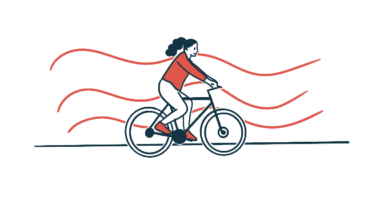More Springtime Light Exposure, Better Sleep With Scenesse: Study

Adults with erythropoietic protoporphyria (EPP) treated with Scenesse (afamelanotide) spent more time exposed to light in springtime, experienced less pain, and slept better, according to a small case-controlled study.
These patients, who experience skin hypersensitivity to sunlight, tolerated increased broad-spectrum white light exposure in the spring months, the study showed.
For the first time, light exposure and sleep activity data were successfully collected by a specialized wristwatch device, suggesting it was a “useful method to objectively measure white light exposure and treatment effects in EPP,” the researchers wrote.
The study, “Objective light exposure measurements and circadian rhythm in patients with erythropoietic protoporphyria: A case-control study,” was published in the journal Molecular Genetics and Metabolism.
Porphyrias are a group of genetic disorders caused by defects in the production of heme, a molecule that helps transport oxygen throughout the body. As a result of these defects, heme precursor molecules called porphyrins build up to toxic levels and cause tissue damage.
EPP is a type of porphyria characterized by the accumulation of a heme precursor called protoporphyrin IX (PPIX) in red blood cells and other tissues, which leads to painful skin hypersensitivity to sunlight from early childhood. As such, avoiding light exposure is recommended for EPP patients.
However, light-avoiding behavior can have adverse effects on quality of life and lead to a deficiency in vitamin D — created by the body when skin is exposed to sunlight — lessening bone density. Further, since light exposure is essential for circadian rhythms, or to regulate the body’s internal clock, EPP patients also may experience sleep problems.
Scenesse is an approved medication used to prevent skin damage caused by sun exposure in adults with EPP. Clinical studies have shown that the therapy safely reduces EPP-related photosensitivity and improves quality of life. Because these trials relied on patient-reported outcomes, however, which are difficult to quantity, the exact magnitude of the effect of Scenesse in EPP is still uncertain.
Now, researchers at the University Medical Center Rotterdam, in the Netherlands, investigated the effectiveness of an actigraph device — a light- and activity-sensing wristwatch — to obtain an objective measure of light exposure in EPP patients. Studies were conducted before and during treatment with Scenesse to assess its impact on pain, circadian rhythms, and sleep.
“This is the first study using an objective outcome measure for evaluating treatment effect in EPP patients, describing the actual total white light exposure in EPP patients, both with and without treatment with [Scenesse],” the team wrote. “We hypothesized that total white light exposure increases and pain scores decrease during [Scenesse] treatment and that sleep and circadian rhythm would improve.”
A total of 26 EPP patients with a mean age of 41.8 years were eligible to participate in the study. Patients were matched with 23 healthy individuals of similar age, sex, and place of residence who served as controls.
All participants wore an actigraph — specifically the Philips Actiwatch Pro — over 14 days. The device continuously collected data related to exposure to broad-spectrum white light and sleep-wake patterns. Researchers described the device as “convenient for patients.”
The EEP patients received 16 mg of Scenesse by controlled release, given via an implant at least 60 days (two months) apart. They wore the actigraph during “on” treatment periods — within 60 days following implantation — or “off” treatment periods, which were those before starting Scenesse or at least 60 days after the last implant.
Pain scores, ranging from 0 for no pain to 10 for most severe pain were entered into the actigraph twice daily, at 9 a.m. and 6 p.m., with an alarm used as a reminder.
Actigraph data revealed that compared with EPP patients during “off” treatment periods, the healthy controls were significantly more exposed to white light in the autumn (by 95.4%), in the spring (by 69.9%), and in summer (by 105.4%).
In the spring, EPP patients during “on” treatment periods experienced significantly more light exposure (by 71.6%) than during “off” periods. Differences in light exposure in summer, autumn, and winter did not differ between treatment periods.
Across both groups, there were no differences in white light exposure between participants of different ages and gender. Still, employed participants were significantly more exposed to white light than retirees (54.2% less) and unemployed participants (56.4% less).
“Employed EPP patients will be expected by their employer to follow a normal rhythm despite having EPP and are likely to adapt to these work requirements, for instance by using a protective foil in their car or by wearing protective clothing,” the researchers wrote.
The EPP patients reported pain on 13% of the mornings while off treatment. This significantly decreased to 6.5% of the days after treatment. In the evenings, pain was reported 20.1% of the time without treatment, significantly declining to 12.0% after receiving the Scenesse implant.
Pain scores were slightly higher in the evenings compared with mornings, “which can be related to the accumulated light exposure over the preceding day,” the researchers wrote. However, the difference in scores relating to “on” or “off” treatment was not statistically significant.
Sleep data showed EPP patients during “off” periods went to bed later (11:45 p.m.) than healthy individuals (11:03 p.m.) or patients on treatment (11:14 p.m.). There were statistically significant differences in bedtime across all three groups.
Wake-up time also was significantly different between the three groups, with “off” treatment patients rising the latest at 8:13 a.m., “on” treatment patients at 7:41 a.m., and controls at 7:46 a.m.
In addition, EPP patients on treatment slept the longest (476 minutes or 7.93 hours) compared with those off treatment (452 minutes or 7.53 hours) and controls (449 minutes or 7.48 hours). Treated EPP patients also were the most efficient sleepers — being asleep 90.9% of the time while lying in bed.
“Our findings confirm the effectiveness of [Scenesse] treatment in EPP patients,” the authors wrote. “Our results were obtained using an actigraph, demonstrating that absolute total white light exposure can be used as an objective outcome measure.”








